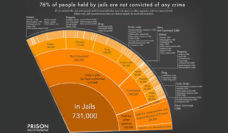Over 1.4 million people are incarcerated in state and federal prisons. For every 100,000 people in this country, 655 are in prison, a rate far surpassing other high-income countries.
Individuals in jails and prisons have higher rates of mental and physical health problems. Incarceration has also been linked to poor outcomes in the physical health of children separated from incarcerated parents. Most research looking at the connections between health and incarceration focuses on the burdens carried by incarcerated people or their families. A recent study by Sandhya Kajeepeta expanded the focus to measure the effects of imprisonment on entire neighborhoods. By considering county-level incarceration and mortality rates, the researchers found a 0.4 percent increase in mortality for every one-percent increase in incarceration, as shown in the figure.
This association is strongest in younger populations, particularly those between the ages of 15 and 34 and people of color, especially Blacks.
Beyond mortality effects, whole communities are afflicted by incarceration. Removing people from their social networks destabilizes families emotionally and financially. Social services and local economies are disrupted as citizens are taken from the workforce and later attempt reentry with low resources and high stigma. Other studies have shown increased neighborhood rates of major depressive disorder, general anxiety disorder, high cholesterol, and drug overdose death as incarceration rates increase. The community-wide, family, and individual consequences of incarceration are exacerbated in Black communities.
The criminal justice system is envisioned as a set of places and practices separating good citizens from criminals. However, these systems of punishment may harm the communities they supposedly protect.
Databyte via , 2020: County Jail Incarceration Rates and County Mortality Rates in the United States, 1987–2016. American Journal of Public Health 110, S109_S115.














